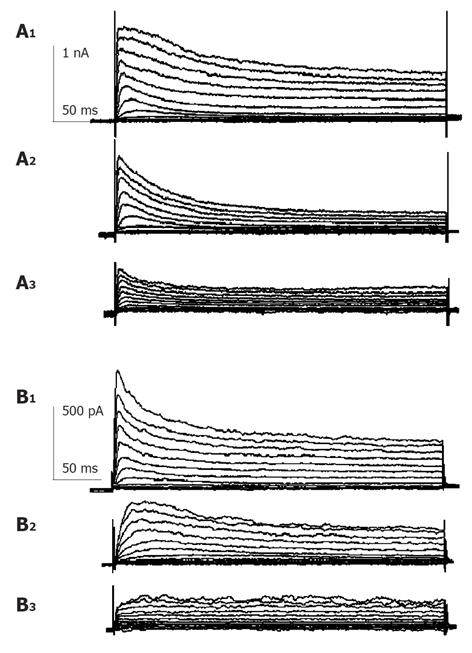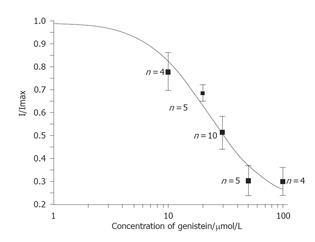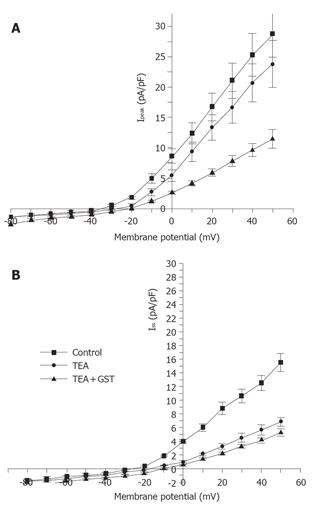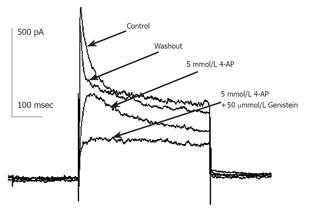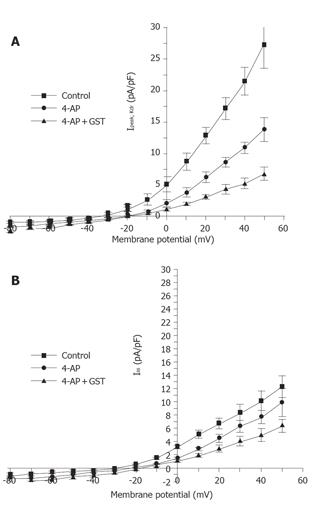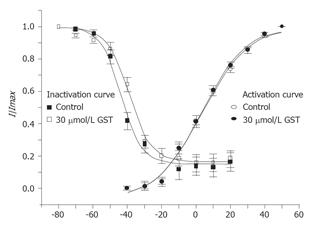Copyright
©2006 Baishideng Publishing Group Co.
World J Gastroenterol. Jan 21, 2006; 12(3): 420-425
Published online Jan 21, 2006. doi: 10.3748/wjg.v12.i3.420
Published online Jan 21, 2006. doi: 10.3748/wjg.v12.i3.420
Figure 1 Two components of voltage-gated potassium currents in guinea pig colon smooth muscle cells and effect of GST.
A1-A3: Currents recorded every 10 s between -80 and +50 mV then back to -40 mV with holding potential -80 mV in the control (A1), in the presence of 10 mmol/L TEA (A2) and TEA and 30 µmol/ GST (A3). B1: Currents recorded every 10 s between -80 and +50 mV with holding potential -80 mV in the control; B2: current in the presence of 5 mmol/L 4-AP developed slowly and showed slower inactivation over 400 ms; B3: effect of 50 µmol/L GST in the presence of 5 mmol/L 4-AP.
Figure 2 Concentration-dependent inhibition of transient outward potassium currents by genistein in guinea pig colon smooth muscle cells.
Currents were elicited by depolarization to +50 mV for 400 ms then back to -40 mV from holding potential of -80 mV. Washout was performed for about 2 min.
Figure 3 Average concentration-dependent transient outward potassium currents inhibited by genistein.
Peak currents were measured and normalized by control current amplitude. The smooth line represents the best fitting with Hill equation. Data are expressed as mean±SE. The number of cells used in each concentration is indicated besides the error bars.
Figure 4 Effect of genistein (30 µmol/L) on current-voltage relationship of transient outward potassium current (IKto) in guinea pig proximal colon smooth muscle cells in the presence of TEA (10 mmol/L) and Cd2+ (0.
2 mmol/L). A: I-V curves of peak current density of voltage-gated potassium channels under control condition (solid square), in the presence of 10 mmol/L TEA (solid circle) as well as 10 mmol/L TEA and 30 µmol/L genistein (solid triangle); B: I-V curves of steady state current density of voltage-gated potassium channels under control condition, in the presence of 10 mmol/L TEA as well as 10 mmol/L TEA and genistein (30 µmol/L). n = 6 cells.
Figure 5 Effect of genistein on delayed rectifier potassium currents in the presence of 4-AP in guinea pig colon smooth muscle cells.
Currents were elicited by depolarization to +50 mV for 400 ms then back to -40 mV from holding potential of -80 mV. Washout was performed for about 2 min.
Figure 6 Effect of genistein (50 µmol/L) on current-voltage relationship of delayed rectifier potassium current (IKdr) in guinea pig proximal colon smooth muscle cells in the presence of 4-AP (5 mmol/L) and Cd2+ (0.
2 mmol/L). A: I-V curves of peak current density of voltage-gated potassium channels under control condition, in the presence of 5 mmol/L 4-AP as well as 5 mmol/L 4-AP and 50 µmol/L genistein; B: I-V curves of steady state current density of voltage-gated potassium channels under control condition, in the presence of 5 mmol/L 4-AP as well as 5 mmol/L 4-AP and 50 µmol/L genistein. n = 4 cells.
Figure 7 Effect of GST on steady state activation and inactivation of transient outward potassium currents.
Inactivation is shown as a plot of normalized peak current as a function of conditional potential from -80 to +20 mV. For voltage dependence of activation, normalized currents were calculated by dividing peak outward currents by their driving force and plotted against potential. Smooth curves were fitted with Boltzmann equation which yields values of half-maximally activated or inactivated voltage (Vh) and slope constant (K).
Figure 8 Orthovanadate antagonizes the inhibition of transient outward potassium currents by genistein.
- Citation: Li SY, Huang BB, Ouyang S. Effect of genistein on voltage-gated potassium channels in guinea pig proximal colon smooth muscle cells. World J Gastroenterol 2006; 12(3): 420-425
- URL: https://www.wjgnet.com/1007-9327/full/v12/i3/420.htm
- DOI: https://dx.doi.org/10.3748/wjg.v12.i3.420









